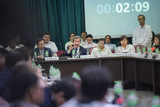Needed: Toilets, books, classrooms

MANILA, Philippines - "Sir, Madi ak nag masirek ta adda diarrhea." (Sir, please excuse me for being absent today because I have diarrhea.)
This is one of the excuse letters that Huebert Lorenzo would usually receive from his students in a primary school in Bgy Maligaya, Alfonso Lista, Ifugao.
The 26-year-old teacher said 8 of his 25 students suffered from diarrhea last school year (2011-2012). A doctor came up and distributed chlorine to help disinfect the water coming from two wells, the main sources of the community's drinking water.
According to Lorenzo, the water treatment happened only once, and it was the only time during the school year that the students in the remote indigenous village saw a doctor.
Basic services hardly reach the village of Maligaya. Until now, it has no electricity and could only be reached using a motorcycle.
School brigade
During the kick-off event of the annual Brigada Eskwela in Manila on Monday, May 21, Unicef country representative Tomoo Hozumi noted that diarrhea, along with stomach pain, is one of the most common health-related complaints among students in the Philippines.
Hozumi added that 2 out of 3 elementary students have intestinal worms, stressing that worm infestations cause serious health problems like malnutrition, anemia, stunted growth and even loss of IQ (an average 3.75 points per child). It also affects a child's ability to concentrate and perform well in school, Hozumi said.
This year's Brigada Eskwela, the national schools maintenance campaign of the Department of Education (DepEd), seeks to raise awareness about the need for school sanitation and improvement of schools in indigenous communities.
In a statement, Education Secretary Armin Luistro said, "School hygiene should not be overlooked as well as the schools catering to IPs [indigenous peoples].”
The week-long event also involves cleaning up and doing repairs in public schools across the country for the opening of classes on June 4.
Essential health care
Since Maligaya Primary School opened in 2009 for pre-school and grades 1 to 2 students, Lorenzo has been trying to sustain a basic health care program. But he and his only co-teacher could do only so much.
Lorenzo said that last school year, the children were dewormed only once. He and his students share a common toilet without soap. They have to fetch water from a well before they could wash their hands.
According to Unicef, an ideal program that could effectively enhance the health of children includes daily handwashing with soap, toothbrushing with flouride toothpaste, and regular deworming (twice a year).
"It has been found to increase school attendance by up to 27%, while reducing worm infestation, dental caries, and malnutrition among school children," Hozumi said.
The essential health program is cost-effective and simple to implement. Merlie Asprer, operations manager of DepEd's Adopt-A-School program, pegged the cost of an essential health package (toothbrush, toothpaste with fluoride, and soap) at P25. The problem is that there is no budget to purchase the items for at least 22 million students.
Asprer had to tap resources of local government units and the private sector to fund the program.
Crowded CRs
The inaccessibility of safe water and clean toilets is a bigger obstacle to addressing health problems among students in the Philippines.
Available data from DepEd's Basic Education Information System (BEIS) show that 20% of public schools have no water supply while only 50% of the schools have access to wells and springs.
Morever, DepEd admitted a backlog of 124,286 toilets for the school year 2012-2013.
Hozumi said that more than 50 elementary students in the country share one toilet. The number is 6 times higher in poorer regions like the Autonomous Region in Muslim Mindanao (ARMM).
Based on international standards, there should be no more than 25 students sharing a toilet.
Books and rooms first
With the help of the community and his only co-teacher, Lorenzo said he complied with the DepEd directive to conduct preparation activities until May 26. But toilets are the least of his concerns come opening of classes.
Lorenzo enumerated what he feels his school immediately needs in this order: books, classrooms, chairs, school supplies and water.
"Saan kami kukuha ng aklat? Yung mga upuan? 40 pa ang kulang," Lorenzo said. (Where are we getting funds for books? For chairs? We still need 40 chairs.)
Lorenzo, who handles 2 grade levels, lamented that he shares every textbook he has with all of his students.
"Kung kulang ang aklat sa paaralan parang walang laman na rin ang tiyan. Ang aklat ay isa sa pinakamahalagang bagay sa isang paaralan," Lorenzo said. (A school that lacks books is like an empty stomach. Books are one of the most important things in a classroom).
Moreover, with the opening of grade 3 in 2011 and the expected opening of grades 4 to 6 this school year, the only 2 functional classrooms in the village could no longer accommodate the growing number of enrollees.
According to DepEd, there is an estimated classroom backlog of 66,800 in public schools. President Benigno Aquino III promised to build 15,000 more classrooms by 2013 and eliminate the shortage in the third year of his administration.
Lorenzo has not heard of any plan to build a new classroom, but he said he would be glad if one of those new structures started to rise in Maligaya Primary School - Rappler.com















